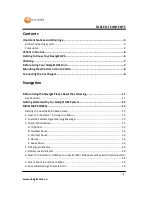
18
Using the
DGPS 53
Operation
$PGRMT,<1>,<2>,<3>,<4>,<5>,<6>,<7>,<8>,<9>*hh<CR><LF>
<1> Product, model and software version
<2> ROM checksum test, P = pass, F = fail
<3> Receiver failure discrete, P = pass, F = fail
<4> Stored data lost, R = retained, L = lost
<5> Real time clock lost, R = retained, L = lost
<6> Oscillator drift discrete, P = pass, F = excessive drift detected
<7> Data collection discrete, C = collecting, null if not collecting
<8> Board temperature in degrees C
<9> Board configuration data, R = retained, L = lost
3D velocity Information (PGRMV)
The GARMIN Proprietary sentence $PGRMV reports three-dimensional velocity information.
$PGRMV,<1>,<2>,<3>*hh<CR><LF>
<1> True east velocity, -514.4 to 514.4 meters/second
<2> True north velocity, -514.4 to 514.4 meters/second
<3> Up velocity, -999.9 to 9999.9 meters/second
DGPS Beacon Information (PGRMB)
The GARMIN proprietary sentence $PGRMB reports DGPS beacon information.
$PGRMB,<1>,<2>,<3>,<4>,<5>,K*<CR><LF>
<1> Beacon tune frequency, 0.0, 283.5 – 325.0 kHz in 0.5 kHz steps
<2> Beacon bit rate, 0, 25, 50, 100, or 200 bps
<3> Beacon SNR, 0 to 31
<4> Beacon data quality, 0 to 100
<5> Distance to beacon reference station in kilometers
One-Pulse-Per-Second Output
The highly accurate (within 1ms) one-pulse-per-second (PPS) output is provided for applications
requiring precise timing measurements. The signal is generated after the initial position fix has been
calculated and continues until power down. The rising edge of the signal is synchronized to the start
of each GPS second.
Regardless of the selected baud rate, the information transmitted by the DGPS 53 is referenced to the
pulse immediately preceding the NMEA 0183 RMC sentence.
The accuracy of the PPS output is maintained only while the DGPS 53 can compute a valid position
fix. To obtain the most accurate results, the one-pulse-per-second output should be calibrated against
a local time reference to compensate for cable and internal receiver delays and the local time bias.
The default pulse width is 100 msec, however; it may be programmed in 20 msec increments
between 20 msec and 980 msec as described in $PGRMC on page 12.













































